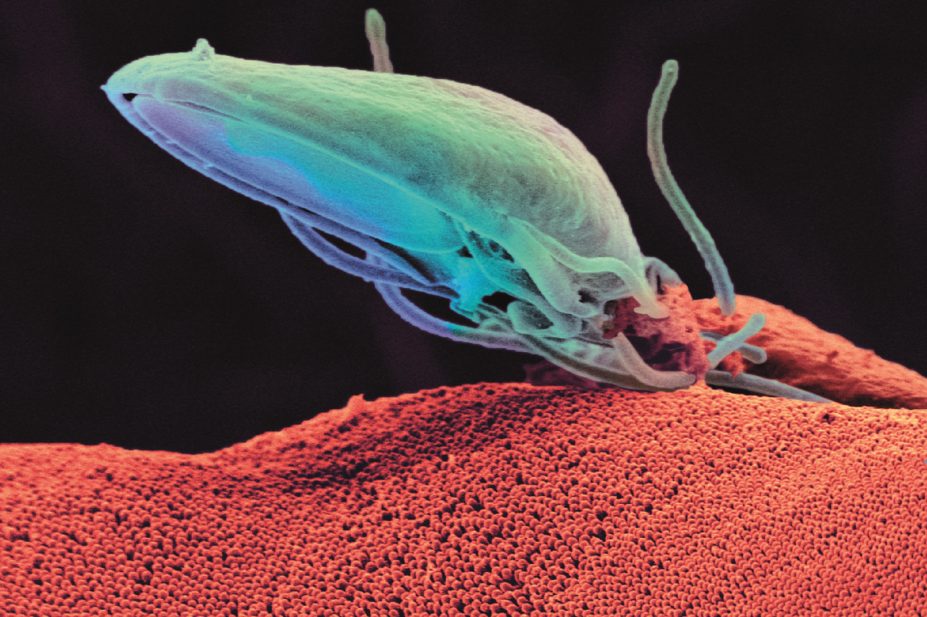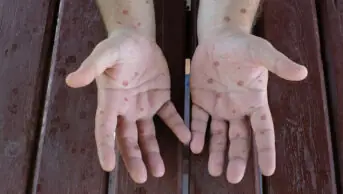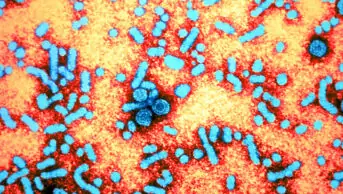
AMI Images / Science Photo Library
Summary box
In this article you will learn:
- The common causes of food poisoning
- How to assess the severity of food poisoning
- When to refer a patient with diarrhoea and vomiting
The World Health Organization (WHO) estimates around 2.2 million people are killed annually by a combination of foodborne and waterborne diarrhoeal diseases[1]
. Each year in the UK, foodborne illness affects around one million people, leads to around 20,000 people receiving hospital treatment, and causes 500 deaths. It is also estimated to cost the UK economy nearly £1.5bn each year[2]
.
Food poisoning is caused by ingesting food contaminated with microorganisms, such as bacteria, viruses, protozoa (enterotoxic) or toxins (exotoxic)[3]
.
Enterotoxic poisoning
Common causes of enterotoxic food poisoning include Campylobacter species, Salmonella species, enterovirulent Escherichia coli (for example, E. coli O157:H7) and Listeria monocytogenes. Symptoms usually last for more than 12 hours.
Campylobacter is responsible for the greatest number of food poisoning cases in Europe each year. Campylobacter is found in chicken (which is responsible for 60–80% of campylobacter food poisoning cases), red meat, unpasteurised milk and untreated water. It has a low infective dose, so relatively few bacteria are needed to cause infection.
Salmonella bacteria can be found in raw meat, poultry, eggs, unpasteurised milk and untreated water.
Most cases of E. coli food poisoning occur after consuming undercooked beef (particularly ground mince products) or unpasteurised milk.
L. monocytogenes is found in soft cheese, vacuum-packed foods and unwashed vegetables. Although relatively rare, infections caused by listeria can cause severe illness requiring hospitalisation, with around one third of cases resulting in death[2]
. L. monocytogenes is responsible for the largest number of deaths associated with food poisoning in the UK, causing more deaths each year than salmonella and E. coli O157 combined[2]
.
Shigella species cause bacillary dysentery or shigellosis, which is the most common form of dysentery in the UK. It is characterised by loose, small-volume stools with blood and mucus, which is often associated with abdominal cramps and pyrexia. Shigella bacteria are found in faeces and can be transferred to foods through poor hygiene.
Norovirus is commonly referred to as the winter vomiting bug, although it can be contracted at any time of year. It is highly contagious and causes vomiting and diarrhoea. It can be transmitted person to person or by touching surfaces that have become contaminated with the virus. The incubation period is 12–48 hours, during which time an individual may be infectious. Food handling during infection may result in passing the virus on to others. Norovirus is the most common cause of gastroenteritis in the UK and there are at least 25 different strains of the virus. However, it is possible to develop a norovirus infection without eating contaminated food.
Giardiasis is an infection caused by the parasite Giardia intestinalis, which is usually contracted by drinking contaminated water. Giardiasis is widespread in sub-Saharan Africa, Central and South America, and Eastern Europe, including the Balkan states, Russia and Turkey. Giardiasis causes diarrhoea, flatulence, abdominal cramps and bloating.
Exotoxic poisoning
The onset of symptoms following exotoxic food poisoning, typically vomiting and diarrhoea, is usually rapid and often resolves within 12 hours; this rapid onset of symptoms is the key way to differentiate exotoxic poisoning from an enterotoxic cause.
Toxins that cause food poisoning may be intrinsic chemical toxins produced by bacteria present in the food, such as Staphylococcus aureus, Clostridium botulinum and Bacillus cereus, or may be extrinsic chemical toxins, such as pesticides.
Foods and contaminants that are responsible for exotoxic poisoning include:
- Legume toxins — found naturally in plants, such as phytohaemagglutinin lectins in red kidney beans;
- Algal toxins — formed by algae in sea and fresh water, most commonly found in shellfish such as mussels, scallops and oysters;
- Scrombotoxins — found in fish such as tuna and mackerel, formed when the fish has not been properly refrigerated or preserved;
- Mycotoxins — toxins from fungi grown on food (for example, toxins from Claviceps purpurea, which grows on rye, can cause ergotism, gangrene and loss of limbs).
Assessment
It is important to determine the severity of food poisoning by asking the patient about their illness, including the frequency and consistency of stools; whether there is any blood in the stool; the frequency of vomiting; and the patient’s ability to eat and drink. The patient’s temperature should also be measured.
The patient’s medical history should be taken, as patients who are immunocompromised or have comorbidities (for example, renal impairment, inflammatory bowel disease, diabetes mellitus, or connective tissue disorders) are at greater risk of more severe disease and complications.
Patients should also be assessed for features of dehydration. These include:
- Mild dehydration — lassitude, anorexia, nausea, light headedness, postural hypotension;
- Moderate dehydration — apathy or tiredness, dizziness, nausea, headache, muscle cramps, oliguria (low urine output), reduced skin elasticity, dry tongue or sunken eyes;
- Severe dehydration — profound apathy, weakness, confusion leading to coma, shock recognised by tachycardia, oliguria, low blood pressure[4]
.
Elderly and pregnant women are at increased risk of serious dehydration and complications.
It is also important to investigate potential causes, contributing factors and differential diagnoses. These include recent contact with someone who has acute diarrhoea or vomiting, known exposure to contaminated food, recent foreign travel, or drug-induced diarrhoea (for example, recently starting proton pump inhibitors or metformin).
Patients should be referred to a GP if symptoms have lasted more than 72 hours in healthy adults, over 48 hours in the elderly or frail, or more than 24 hours in patients with diabetes due to increased risk of poor outcome. Patients should also be referred if they present with diarrhoea associated with severe vomiting, fever and dehydration, if they have blood or mucus in stools, or if an adverse drug reaction is suspected.
If diarrhoea occurs after travel to anywhere other than Western Europe, North America, Australia, or New Zealand, the patient should be referred to a GP, who will collect a stool specimen to send for laboratory testing[4]
.
Laboratory testing of stool specimens is usually not necessary for most adults who present with acute, watery diarrhoea. However, stool cultures should be analysed when the person is systemically unwell or immunocompromised; if there is pus or blood in the stool; if there is a recent history of hospitalisation or antibiotic treatment; if diarrhoea is persistent and giardiasis is suspected; or if diagnosis is uncertain.
Management
Oral rehydration salt solutions do not reduce the duration or frequency of diarrhoea, and are not recommended for healthy adults who can maintain fluid intake with supplementary fruit juice and soups[4]
. However, they should be considered for patients at increased risk of a poor outcome (for example, older patients or those with comorbidities such as cardiovascular disease). There is emerging evidence that probiotics can be a useful adjunct to rehydration therapy in treating acute, infectious diarrhoea in adults, but more research is needed to confirm which particular probiotics are most beneficial in specific patient groups[5]
.
Some medicines, such as diuretics and angiotensin converting enzyme inhibitors, can exacerbate dehydration and therefore it is important to ensure adequate fluid intake. The efficacy of some medicines, including the oral contraceptive pill, warfarin and anticonvulsants, may be affected by severe diarrhoea.
Expert opinion varies on the role of diet following food poisoning. Some suggest that eating stimulates the gastrocolic response, and therefore avoiding food may reduce defecation, while others suggest that solutes in foods may have a beneficial effect on rehydration. The National Institute for Health and Care Excellence (NICE) recommends that, after the patient is rehydrated, eating should be guided by appetite[4]
. Small, light and non-spicy meals may be more desirable to the patient and better tolerated.
Antimotility medicines are not usually necessary in managing food poisoning. However, they can be recommended to adults with mild-to-moderate diarrhoea, especially if faster resolution of diarrhoea would facilitate continuation with essential activities. Loperamide is the treatment of choice due to its peripheral action, and stronger evidence for its efficacy and better side effect profile compared with alternatives. Bismuth subsalicylate can be used by patients with traveller’s diarrhoea.
Antimotility medicines should not be prescribed in patients with:
- Possible dysentery (e.g. blood or mucus in the stools, high fever);
- Confirmed or suspected vero cytotoxin-producing E.coli 0157 (VTEC) infection, because antimotility medicines can increase the risk of haemolytic uraemic syndrome or neurological complications;
- Shigellosis, because antimotility medicines can worsen the condition.
Antiemetics are not usually necessary, although intramuscular metoclopramide 10mg may be used in severe vomiting.
Antimicrobials are not recommended for adults with acute diarrhoea of unknown cause, as evidence suggests that benefits are minimal[4]
. Antimicrobials are not usually necessary for patients with mild campylobacter infections, and are not recommended for healthy people with poisoning caused by salmonella or mild shigellosis. Antimicrobials should not be used to treat infection with E.coli 0157 (VTEC).
However, antimicrobials may be appropriate for patients who have acute diarrhoea with an identified microbiological cause, or in patients who are immunocompromised, elderly or who have a severe or prolonged infection.
Food poisoning is a notifiable disease[6]
. Registered medical practitioners have a statutory duty to notify the local council or local health protection team of suspected cases of food poisoning. The local environmental health department should be informed if food poisoning is suspected to be caused by food from a specific restaurant, takeaway or shop.
Food poisoning prevention advice
- Wash and dry hands thoroughly with soap and hot water before and after handling food
- Wash worktops before and after preparing food, especially raw meat
- Wash dishcloths and tea towels regularly
- Use separate chopping boards for raw food and ready-to-eat food
- Keep raw meat separate from ready-to-eat food
- Store meat on the bottom shelf of the fridge and prevent drips on to other foods
- Cook food thoroughly and check that it’s piping hot all the way through
- Keep fridge temperature below 5°C
- Cool leftovers quickly (within 90 minutes) and store in the fridge or freezer
- Respect ‘use-by’ dates
Lisa Jamieson, BPharm (Hons) MSc MRPharmS is a freelance pharmacy writer.
References
[1] World Health Organization. Sixty-Third World Health Assembly: Food Safety. Geneva: WHO 2010.
[2] Food Standards Agency. Foodborne Disease Strategy 2010–15 — An Fsa Programme For The Reduction Of Foodborne Disease In The UK. London: FSA 2011.
[3] Blackburn CW, McClure PJ. Foodborne Pathogens — Hazards, Risk Analysis and Control (2nd Edition). Woodhead Publishing 2009.
[4] National Institute for Health and Care Excellence. Clinical Knowledge Summaries: Gastroenteritis. August 2014.
[5] Allen SJ, Okoko B, Martinez EG et al. Probiotics for treating infectious diarrhoea. Cochrane Datab Syst Rev 2003;4. Art. No.: CD003048.
[6] Public Health England. Notifiable diseases and causative organisms: how to report. London: PHE 2010.


